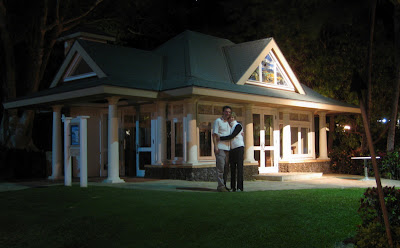We started the day with a leisurely breakfast.

I am easily adapting to the concept of chocolate with every meal...

definitely a breakfast of champions!

Then we drove "The Saddle Road" on the flanks of Mauna Kea to the other side of the island. Mauna Kea reigns as the "tallest" mountain in the world, or so our ranger told us -- over 33,000 ft from the floor of the ocean! Everest is the "highest" mountain in world, since its measure of height begins at the continental plate, i.e. sea level.

Four wheel drive is advised attempt the summit of Mauna Kea, where some of the most sophisticated telescopes in the world are located. We settled for a glimpse of the sun through this telescope before continuing our journey...

down from the "saddle" between Mauna Kea & Mauna Loa with views of the clouds and the coast below.

At Hawaii Volcanoes National Park, Ranger Dean (who in a previous life was surely a stand-up comedian) informed us that the Hawaiian islands are drifting northwest 2-4 inches per year (along with the whole continental plate. Apparently, they're sliding over a "hot spot" in the earth's crust, so the next Hawiian island is already forming next to the Big Island down in the ocean depths to the southeast. (We're pretty sure there's a timeshare company somewhere that's already selling units "soon to be ready for occupancy" on this island.)

This side of the island earned it's reputation as "the wet side" during our visit. Also foggy. Looking into the crater of Kilauea, visibility was about 50 ft, with or without contraptions.

A sulfur vent was still hard to find in the midst of all the fog. We had to follow our nose.

The entrance of Thurston Lava tube.

Beyond the developed section of the Thurston Lava Tube an undeveloped section remains to be explored with flashlights for the brave non-claustrophobes who wish to explore another 334 meters of total darkness. We probed the quiet, lonely depths -- an eerie feeling for Jolene -- and turned off the flashlight to experience utter darkness.

Leaving the crater, we headed for the coastline where the lava from a side-vent on Kilauea flows into the ocean.

At most, we were expecting steam and an orange glow, so when we saw hot lava shooting into the air while still driving to the parking area, we were excited and impressed. A short walk by flashlight across the lava takes viewers to a closer view -- as close as the Hawaii Civil Defense, who staff the area, will allow, anyway.

We felt fortunate to be present for this display, as the locals told us this was the most activity they'd seen in 6 months. Steam hissed and popped as jets of hot lava spewed 300-400 feet into the air and waves pounded the coast. It looked like the 4th of July.

Here we stand on young lava. It was a fun but long day, and we returned to our digs looking forward to sleep!
 Happy 9th Birthday, Lauren!
Happy 9th Birthday, Lauren! This was the first time you met Jack. He came to visit you in Minnesota.
This was the first time you met Jack. He came to visit you in Minnesota. A little trail of destruction followed you where ever you went. Here you are emptying the kitchen cupboards!
A little trail of destruction followed you where ever you went. Here you are emptying the kitchen cupboards! You were about 5 months old in this picture with mom and dad!
You were about 5 months old in this picture with mom and dad!








































